Experienced housewives know that the success of cooked dishes largely depends on the properly selected dishes in which they are cooked. Frying pans rightfully occupy a special place among kitchen utensils, because without them it is difficult to imagine the preparation of most of the dishes. It's scrambled eggs for breakfast, pancakes on weekends, and cutlets for dinner - you can't go anywhere without them. But how to choose the one that will become the best assistant in the kitchen? It's time to figure it out.
Content
- 1 Choice theory
- 2 The best frying pans for 2020
- 2.1 CS-Kochsysteme Emden 28 cm
- 2.2 Leonord LEO-26
- 2.3 Frybest Bordo-F28I
- 2.4 Tefal Daily Cook 26 cm
- 2.5 Bekker BK-7948
- 2.6 Bekker Fancy Orange BK-3793 26 cm
- 2.7 Barton Steel BS-7228
- 2.8 Kelli KL-4062 26 cm
- 2.9 Marta PRO LINE MT-3117
- 2.10 Zanussi Capri ZCF53231DF
- 2.11 Alpenkok AK-0043A
- 2.12 NEVA METAL TABLEWARE Altai 26 cm
- 2.13 NEVA METAL TABLEWARE Ferrat Induction 26 cm
- 2.14 NEVA METAL TABLEWARE Special 26 cm
- 2.15 Dream Granite 26 cm
- 2.16 Dewdrop Oliva ROS 52-22 22 cm
- 2.17 Biol 0328
- 2.18 MOULINvilla BS-28-I-DH
Choice theory
Coming to the store for a new frying pan, a huge number of questions arise - this is the material of the frying pan itself, and the coating, handles, diameters, manufacturers, thermal conductivity, interaction with the stove ... Let's start in order.
Pan material
- Cast iron
One of the most famous metals in the manufacture of any structure. Its distinctive feature is good heat retention: it warms up evenly and retains heat for a long time. Moreover, cast iron is very strong and durable - that is, you can not be afraid to use a metal spoon when cooking, and the need to cut something directly in the pan will not bear any consequences. Also, cast iron is considered a "useful" metal, that is, during cooking, food is enriched with iron. Another indisputable plus is that it is not a problem for a cast-iron frying pan to stand for a couple of hours in a red-hot oven.
Of course, there are also disadvantages. These dishes are quite heavy and cannot be washed in the dishwasher. In addition, food left for a long time can provoke rust. Well, from time to time, special care will be needed - to ignite the frying pan with salt and grease it with oil. However, if you follow these simple rules, such a frying pan can serve you for 10, 20 and even 30 years.
- Stainless steel (stainless steel)
Pure uncoated stainless steel cookware is a favorite of many famous chefs. This choice is due to the fact that such pans preserve the color, taste and smell of the ingredients as much as possible. In addition, they are resistant to various types of mechanical and thermal damage - from knives to, for example, washing in cold water immediately after frying.
Of the shortcomings, it can be noted that it is quite difficult to get used to such a frying pan if you have not previously had experience with it - it quickly heats up and gives literally all the temperature that it receives from the stove. That is, any cooking dish will need to be stirred vigorously, otherwise it will stick at first and then burn out.
- Copper
Copper cookware has a stainless steel coating, and also rightfully occupies not the last place in world kitchens. Such utensils have a beautiful and even aristocratic appearance that fits into any interior, but at the same time they have a capricious and restive character - it is difficult to cook in them without proper skill.
An indisputable plus is that copper heats up very quickly and also cools down quickly, that is, it guarantees an almost instant response to changes in the cooking temperature. Also, in such a frying pan, you can cut something or stir with a fork - the coating is resistant to mechanical damage.
Coating
At the moment, non-stick pans are very popular, which allow you to cook without using oil. The basis of such pans is almost always aluminum - a light metal with good thermal conductivity. But everything else depends on the "shell".
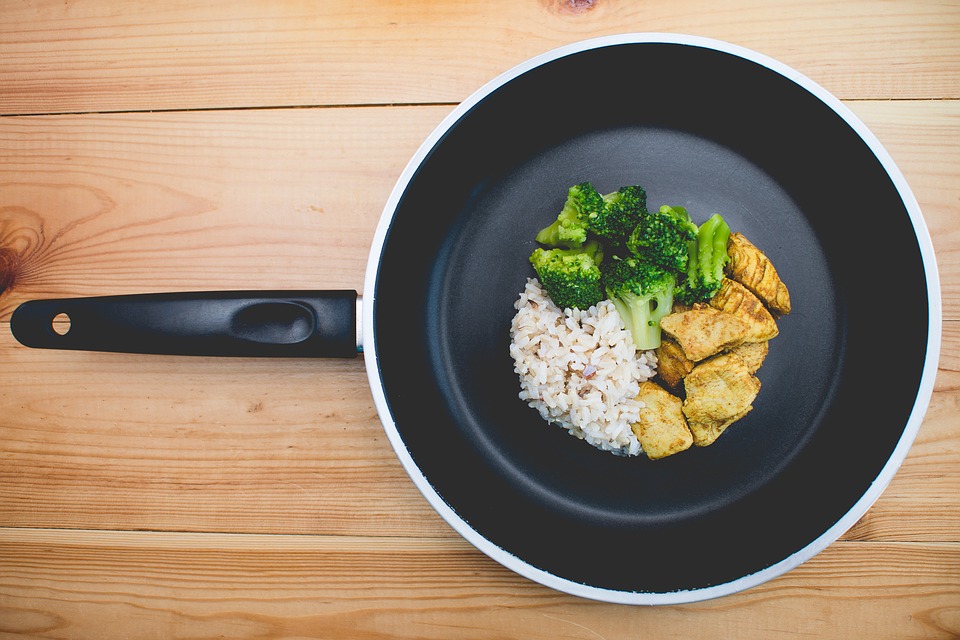
- Teflon
Polytetrafluoroethylene (this is the scientific name for the well-known Teflon coating), is distinguished by a fairly low cost and ease of maintenance. However, he categorically does not tolerate any sharp objects and strong heating (up to 200 degrees) - in such cases, carcinogenic toxic gases begin to be released, which, of course, does not have the best effect on the quality of food and health.
- Ceramics
Such a coating is created from nanocomposite polymers with the smallest particles of sand in the composition. As well as Teflon, a frying pan with a ceramic coating has good non-stick properties, and moreover, it can be heated up to 400 degrees without harm to health. These pans heat up quickly and evenly, and their light weight makes cooking easy.
But, they also have negative aspects. This is fragility and fear of any mechanical damage, incompatibility with a dishwasher and poor susceptibility to temperature extremes. In addition, they are not suitable for induction hobs.
- Marble
These pans, of course, are not made of pure marble, they are all the same Teflon-coated aluminum with the addition of marble chips. Such a frying pan is heavy, but not comparable in weight with a cast iron. But in terms of resistance to damage, she is very eager to catch up with her: purposefully, of course, she does not need to cut anything in it, but she is not afraid of accidental falls or scratches. She is also not afraid of temperature changes, heats up quickly and evenly, cools down rather slowly and looks very solid and unusual.
- Titanium, granite and diamonds
Nanocomposite coatings with such additives can rightfully be considered one of the best: pans with such a coating have good wear resistance, are not afraid of contact with metal objects, quickly and evenly heat up and are absolutely safe for health. Plus, they can last up to 25 years!
Manufacturing
According to the method of making pans, two types are divided: cast and stamped.
Stamped pans are lightweight, convenient and cost effective. However, they are short-lived, so they often need to be replaced every couple of years.
Cast pans are durable, but they are also quite heavy, which is not suitable for every housewife. However, this is their only drawback. Otherwise, such pans have good thermal conductivity, heat up quickly and evenly, cool down for a long time and are suitable for most types of food processing.
A pen
When choosing a frying pan, you should pay special attention to the handle - it should not only fit comfortably in your hand, but also meet safety requirements: it is best to choose rubberized materials or heat-resistant plastic. Silicone and heat-resistant wooden materials are also good - they do not allow you to get burned, and lie pleasantly in the hand, providing minimal slip, and are very environmentally friendly - even with accidental heating they do not emit any toxic substances.
Professional chefs prefer metal handles - they can easily withstand heating up to 400 degrees and meet the most stringent sanitary standards for kitchens that provide catering. However, you cannot do without potholders, therefore, you must observe the utmost care and caution.
Also, the handles of pans are divided into three types according to the method of attachment, these are:
- cast;
- riveted;
- removable.
Of course, the best choice for frequent use is the molded handle. The minimum risk of breakage, as well as a guarantee that there will be no unnecessary damage to the inner surface of the pan.
When choosing riveted handles, you need to pay special attention to the rivets themselves - the larger they are, the better. This is due to the fact that a small mounting area from constant loads can simply break, which will force you to throw out such dishes. But it is worth remembering that dirt that is difficult to wash very often accumulates around the fasteners, and over time, even near the most reliable fasteners, chips and cracks may appear, which can lead to the release of poisonous fumes, especially in Teflon-coated pans.
The removable handles are ideal for those who prefer a variety of cooking methods and complex dishes - if necessary, you can simply remove the handle and send the pan to the oven, and then, without using potholders, pull it out onto the table using the handle.
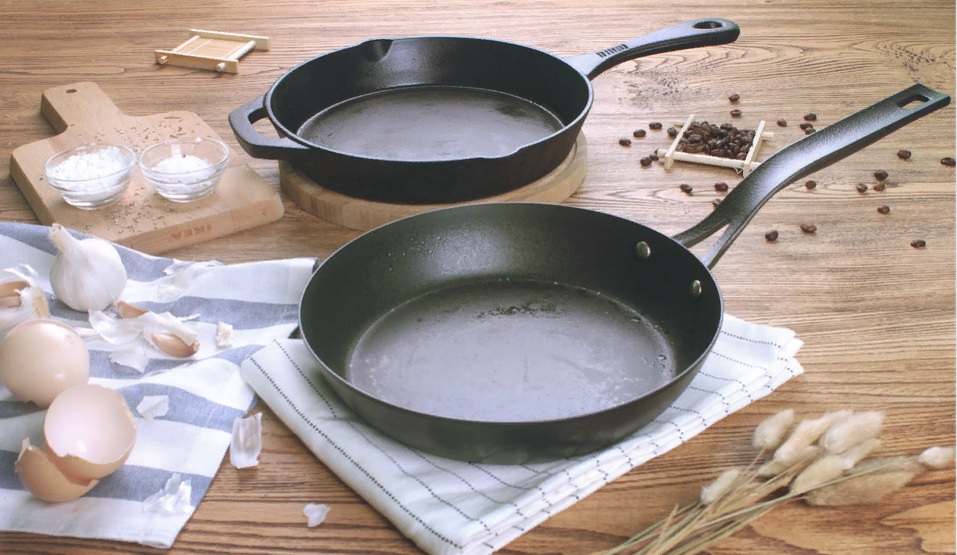
Wall and bottom thickness
This parameter for pans is exactly the case when more is better. The optimal wall thickness for a regular frying pan will be at least 5 mm, and for a pancake pan - at least 3 mm. As for the bottom, it is better to choose a thicker and more massive one.
Such criteria are due to the fact that it is the thick surfaces that are heated most evenly, which allows cooking with minimal effort. In the case of a thin bottom and walls, rapid and uneven heating occurs, and very soon both surface deformation and violations of its integrity may appear. And it is quite difficult to cook in such dishes - food sticking often occurs, burning, or, conversely, insufficient readiness.
Pan size
A common problem is choosing the diameter of a new pan. An important fact: the size is always indicated by the diameter of the edges of the dishes, not the bottom. Of course, first of all you should be guided by your needs, but if you are at a loss with the choice, then here is the average ratio of the diameter of the pan and the number of people on which you can cook something in it:
- 18-20 cm - convenient for warming up food, cooking frying or a modest dinner for 1 person;
- 22-24 cm - perfect for cooking for two;
- 26 cm - this diameter is good for a full dinner for a family of 3 people;
- 28 cm - will allow you to feed a large family of 4-6 people.
Stove Compatibility
The variety of stoves sometimes makes you wonder what kind of dishes you can use on them. In fact, everything is quite simple:
- Gas stoves. The most common and not pretentious ovens. The best choice would be pans with notches on the bottom from the outside - they will allow the dishes to warm up most evenly and efficiently. It is also worth paying attention to the fact that the edges of the pan do not protrude beyond the dimensions of the stove.
- Electric stoves are also unpretentious to the dishes that come into contact with them. However, based on the evenness and size of the burners, it is better to choose pans with an even and thick bottom according to the size of the heating surface. Pans with a thin bottom are often deformed by temperature, so this fact should be taken into account.
- Glass-ceramic hobs require the use of special dishes, but if you want a simple frying pan, then choose models with a perfectly flat outer surface of the pan and a bottom thickness of at least 3 mm. Cast utensils are the best choice.
- Induction hobs require special cookware. Pans made of stainless steel and cast iron work well for them - these metals have magnetic properties. At the same time, the thickness of the bottom should be large so as not to experience difficulties in cooking.
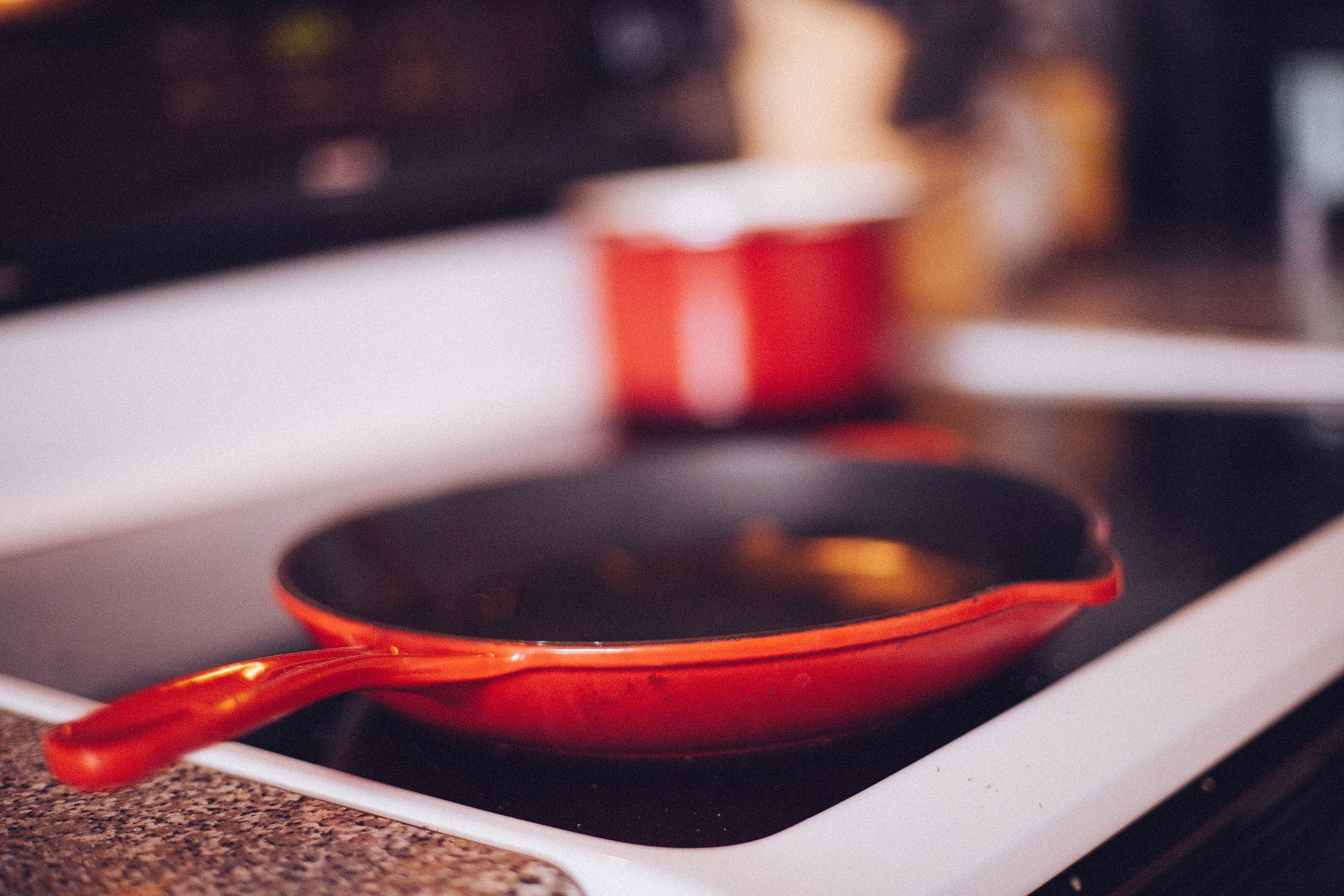
And a few more details
- When buying any kitchen utensils, the best choice is the models that come with a lid. There are metal and glass covers, and it is difficult to say with certainty which of them is the most optimal.Metal lids are practically eternal, however, through glass lids it is much better to observe the cooking process without disturbing the temperature regime (this is especially important for extinguishing).
Glass lids are made of heat-resistant glass and can be divided into one-piece lids and lids with a steam outlet. The latter allow you to preserve the taste and consistency of the prepared dishes in the best way. The handles of such lids can be either metal or made of temperature-resistant plastic. All these nuances are best considered based on your own preferences in cooking.
Particular attention should be paid to the diameters of the lids - if you buy them separately, then focus on the diameter of the pan - as we remember, it is indicated precisely along the upper edge.
- The weight of the frying pan plays a very important role in the event that its use will be associated with frequent movements. However, do not forget that lightweight models are often more prone to deformation due to the small thickness of the walls and bottom, as well as due to the material of manufacture.
- Also, when choosing, you should immediately pay attention to whether the pan can be washed in a dishwasher - often the manufacturer indicates this for each specific model. If there is no such data, then remember that stainless steel pans are best tolerated by such water procedures, and worst of all - from cast iron. Aluminum pans can only be washed in the dishwasher if they have a special protective layer. Pans made from other materials are best washed on a gentle cycle using mild detergents.
The best frying pans for 2020
CS-Kochsysteme Emden 28 cm
A German manufacturer of kitchen utensils with appropriate quality - a good choice in terms of price-performance ratio.
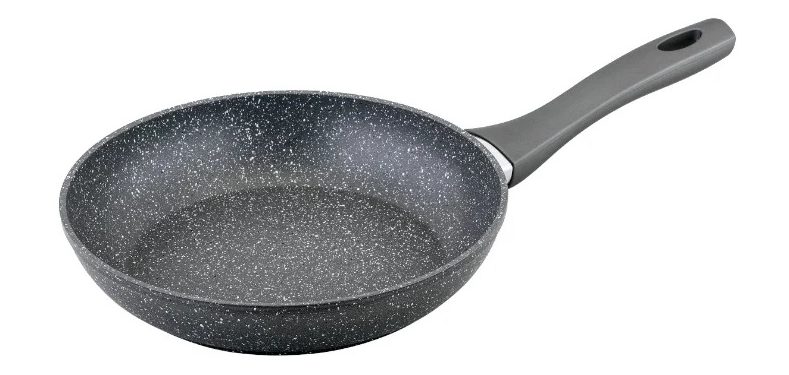
Benefits:
- Forged aluminum;
- Different diameters to choose from;
- Wall thickness 2.5 mm;
- Height 5 cm;
- Non-stick coating;
- Suitable for induction cookers;
- Suitable for dishwashers;
- Affordable cost.
Disadvantages:
- No cover included;
Average price: 1600 rubles.
Leonord LEO-26
A Russian manufacturing company that is rapidly gaining consumer favor with the quality of its products.
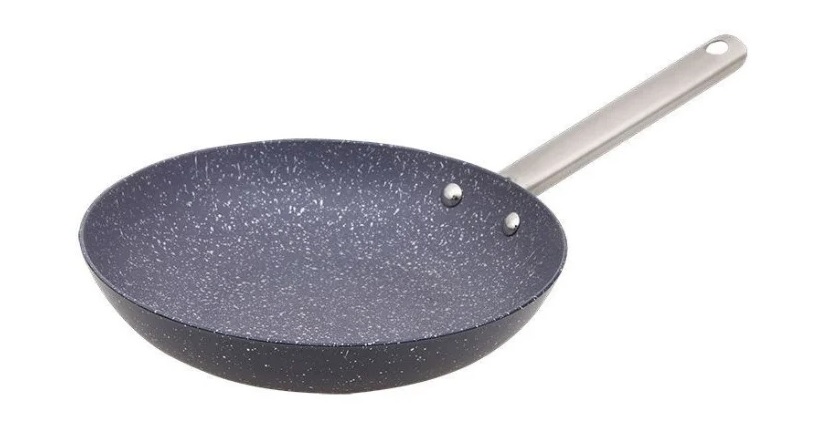
Advantages:
- Cast-iron pan;
- Marble non-stick coating;
- Different diameters to choose from;
- Suitable for induction cookers;
- Can be used in the oven;
- Acceptable cost.
Disadvantages:
- Not suitable for dishwashers;
- No cover included;
- Steel handle - will require the use of tacks.
Average price: 1900 rubles.
Frybest Bordo-F28I
South Korea pleasantly surprises with eco-friendly and high-quality kitchen utensils of a wide variety of shapes, sizes and colors.
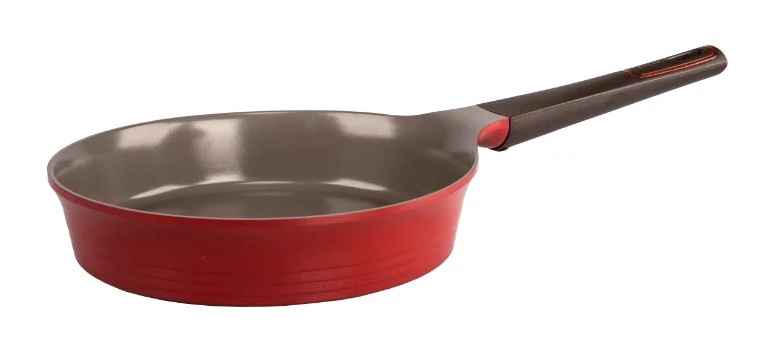
Advantages:
- Cast aluminum;
- Height 5.6 cm;
- Multi-layer bottom;
- Ceramic non-stick coating;
- Different diameters to choose from;
- Suitable for induction cookers;
- Suitable for dishwashers.
Disadvantages:
- No cover included;
- Cannot be used for oven;
- Quite high cost.
Average price: 4600 rubles.
Tefal Daily Cook 26 cm
The French brand known to many offers a very interesting model of pans for constant use.
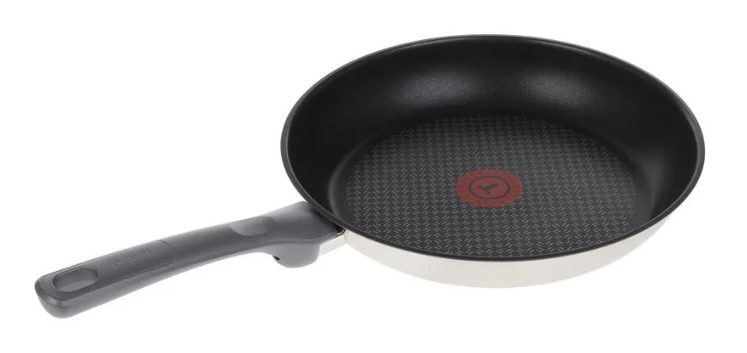
Benefits:
- Steel pan base;
- Non-stick coating;
- Different diameters to choose from;
- Heating indicator;
- Suitable for dishwashers;
- Suitable for induction cookers;
- Suitable for oven use;
- Average cost.
Disadvantages:
- No cover included.
Price: 2500 rub.
Bekker BK-7948
Another German kitchenware company. The extraordinary quality and original design speak for themselves.
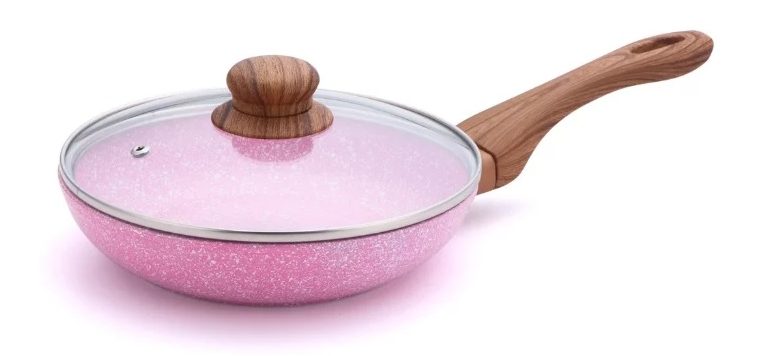
Advantages:
- Forged aluminum base;
- Heat-resistant glass cover with steam outlet included;
- Marble non-stick coating;
- Different diameters to choose from;
- Bottom thickness 3 cm;
- Wall thickness 2.5 mm;
- Suitable for induction cookers;
- Suitable for dishwashers;
- Nice value.
Disadvantages:
- Not found.
Average price: 1500 rubles.
Bekker Fancy Orange BK-3793 26 cm
Another model featuring removable handles and various colors (we stopped at orange).
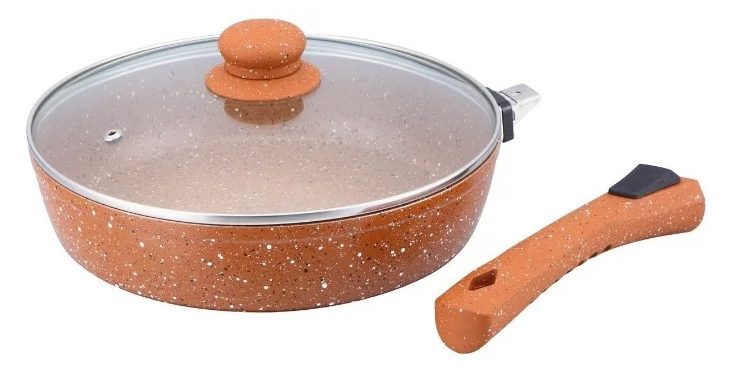
Advantages:
- Forged aluminum base;
- Marble non-stick coating;
- Removable handles;
- Heat-resistant glass cover with steam outlet;
- Bottom thickness 3.5 mm;
- Suitable for induction cookers;
- Suitable for dishwashers;
- Suitable for oven use;
- Nice value.
Disadvantages:
- Not found.
Average price: 1600 rubles.
Barton Steel BS-7228
The manufacturer is distinguished by a wide range of products for both conventional and premium kitchens. The quality of the tableware is rated “excellent” by many buyers.
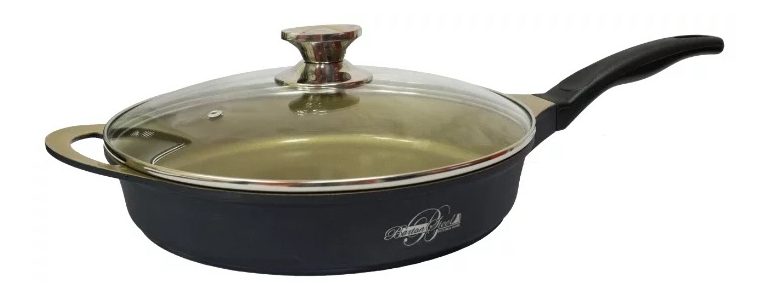
Benefits:
- Base - cast aluminum;
- Ceramic non-stick coating;
- Different diameters to choose from;
- Two handles included;
- Heat-resistant glass cover;
- Dishwasher safe;
- Suitable for induction hob;
- Acceptable cost.
Disadvantages:
- Not found.
Average price: 2400 rubles.
Kelli KL-4062 26 cm
Another Russian brand that is rapidly gaining the love of consumers. Multifunctional, elegant, and most importantly, high-quality products of this manufacturer are increasingly becoming the choice of ordinary citizens.
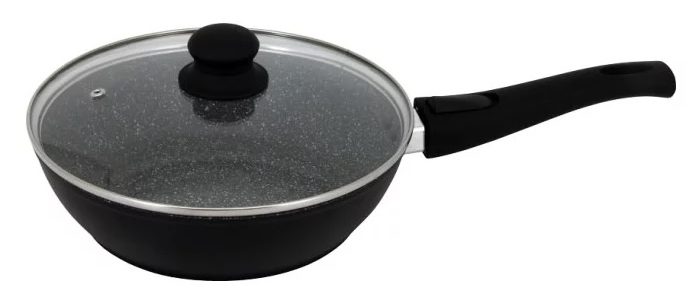
Benefits:
- Base - aluminum;
- Marble non-stick coating;
- Glass cover included;
- Different diameters to choose from;
- Dishwasher safe;
- Suitable for induction hob;
- Suitable for oven use;
- Removable handles.
Disadvantages:
- Heavy (1kg).
Average price: 1400 rubles.
Marta PRO LINE MT-3117
Despite the Chinese production, to which many are prejudiced, the dishes of this brand have earned the trust of many buyers for their quality and availability.
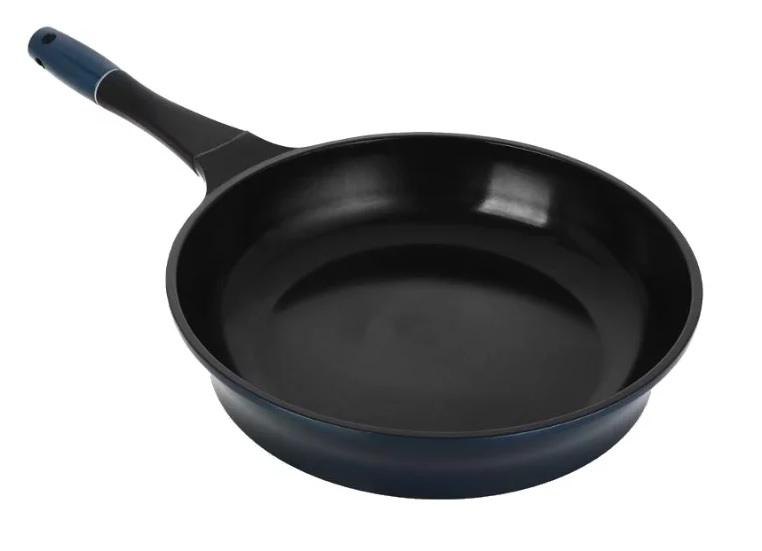
Benefits:
- Die-cast aluminum base;
- Ceramic non-stick coating;
- Removable handles;
- Wall thickness 5mm;
- Suitable for oven use;
- Dishwasher safe;
- Different diameters to choose from;
- Acceptable cost.
Disadvantages:
- Not suitable for induction cookers;
- Sold without a cover.
Average price: 800 rubles.
Zanussi Capri ZCF53231DF
Italian quality, elegance of shapes and discreet, but very rich and luxurious colors - only pleasant sensations from cooking with these pans.
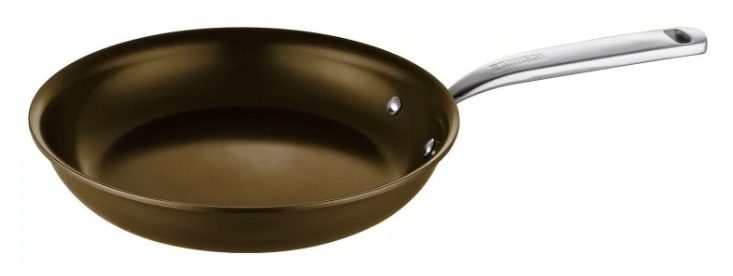
Advantages:
- Base - stamped aluminum;
- Ceramic non-stick coating;
- Multi-layer bottom;
- Wall thickness 4 mm;
- Bottom thickness 4 mm;
- Different diameters to choose from;
- Suitable for induction hob;
- Dishwasher safe;
- Suitable for oven use (up to 260 degrees).
Disadvantages:
- No cover included;
- High price.
Average price: 4000 rubles.
Alpenkok AK-0043A
Despite the low popularity of this brand, its products are able to withstand serious criticism, as they are distinguished by their reliability and quality.
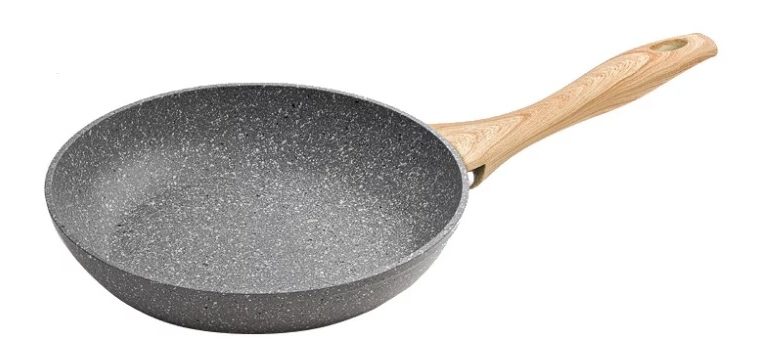
Advantages:
- Base - cast aluminum;
- Non-stick coating;
- Bottom thickness 3 mm;
- Nice cost;
- Different diameters to choose from;
- Suitable for induction hob.
Disadvantages:
- Not dishwasher safe;
- Not suitable for oven use;
- No cover included.
Average price: 900 rubles.
NEVA METAL TABLEWARE Altai 26 cm
A Russian manufacturer that gives a 3-year guarantee for any of its products - you should pay attention to it.
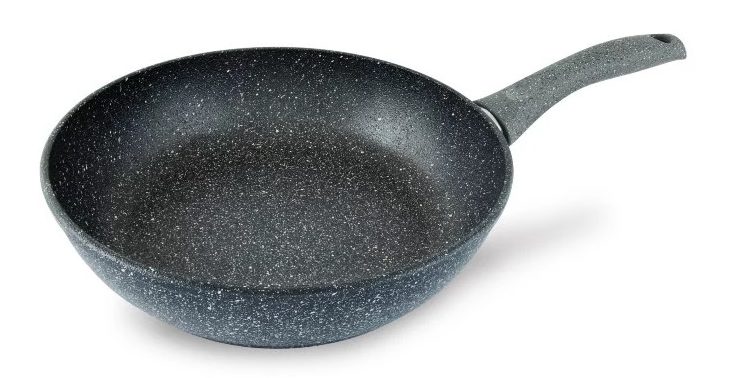
Advantages:
- Base - cast aluminum;
- Marble non-stick coating;
- Bottom thickness 6 mm;
- Wall thickness 3 mm;
- Different diameters to choose from;
- Acceptable cost;
- Long-term factory warranty;
- Dishwasher safe.
Disadvantages:
- No cover included;
- Large weight (1.22kg);
- Not suitable for induction hobs;
- Not suitable for oven use.
Average price: 2800 rubles.
NEVA METAL TABLEWARE Ferrat Induction 26 cm
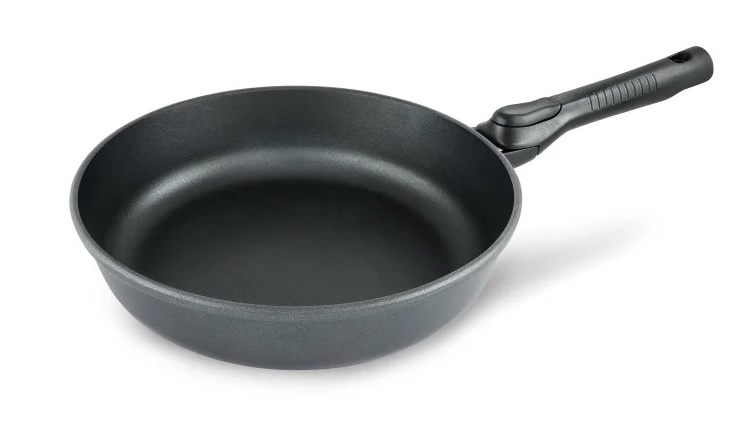
Advantages:
- Base - cast aluminum;
- Titanium non-stick coating;
- Bottom thickness 6mm;
- Wall thickness 3.5 mm;
- Different diameters to choose from;
- Acceptable cost;
- Long-term factory warranty;
- Removable handles;
- Dishwasher safe;
- Suitable for induction hob;
- Suitable for oven use.
Disadvantages:
- Weight (1.34 kg);
- No cover included.
Price: 3000 rub.
NEVA METAL TABLEWARE Special 26 cm
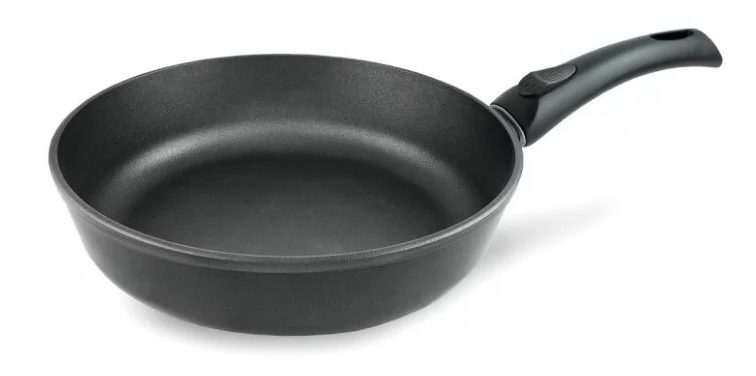
Advantages:
- Base - cast aluminum;
- Titanium non-stick coating;
- Bottom thickness 6 mm;
- Wall thickness 4 mm;
- Different diameters to choose from;
- Acceptable cost;
- Long-term factory warranty;
- Removable handles;
- Dishwasher safe;
- Suitable for oven use.
Disadvantages:
- Not suitable for induction cookers;
- Weight.
Average price: 2600 rubles.
Dream Granite 26 cm
Another underrated by many Russian brand that produces high-quality kitchen utensils.
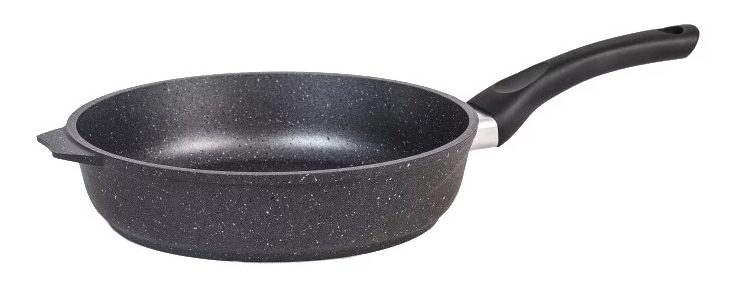
Advantages:
- Base - cast aluminum;
- Greblon non-stick coating;
- Bottom thickness 6 mm;
- Wall thickness 4 mm;
- Two handles included;
- Various diameters to choose from.
Disadvantages:
- Not suitable for induction cookers;
- Not suitable for dishwashers;
- Not suitable for baking in the oven;
- Does not include a cover;
- Weight (1.18 kg).
It is worth noting that like a regular frying pan for a gas or electric stove, such a frying pan is ideal and will be a durable acquisition with proper care.
Average price: 1300 rubles.
Dewdrop Oliva ROS 52-22 22 cm
A Russian brand that is also undeservedly overlooked. Pans from this manufacturer are simple and unpretentious, therefore they are perfect for use on gas and electric stoves.
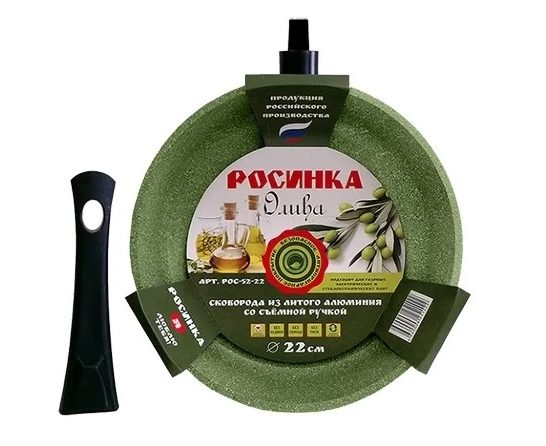
Advantages:
- Base - cast aluminum;
- Quan Tanium non-stick coating;
- Different diameters to choose from;
- Bottom thickness 6 mm;
- Wall thickness 4 mm;
- Removable handles;
- Nice value.
Disadvantages:
- No cover included;
- Not suitable for induction hobs.
Average price: from 1100 rubles.
Biol 0328
The Ukrainian company that produces kitchen utensils according to high environmental standards has already been appreciated by many chefs.
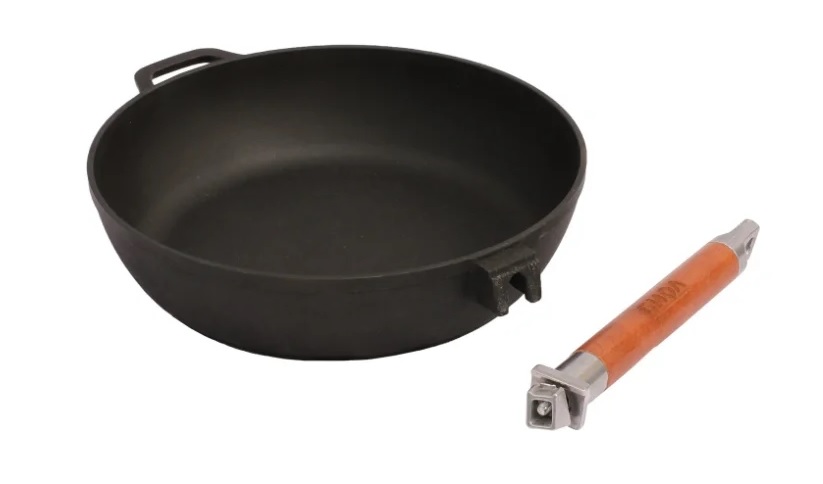
Advantages:
- Manufacturing material - cast iron;
- Bottom thickness 4 mm;
- Wall thickness 3.5 mm;
- Different diameters to choose from;
- Removable wood handles;
- Suitable for oven use;
- Suitable for induction cookers;
- Nice cost;
- Durability.
Disadvantages:
- No cover included;
- Not suitable for dishwashers;
- Weight (2.63 kg)
Average price: 1600 rubles.
MOULINvilla BS-28-I-DH
A well-known brand, most often found in large hypermarket chains, with reasonable prices and high quality.
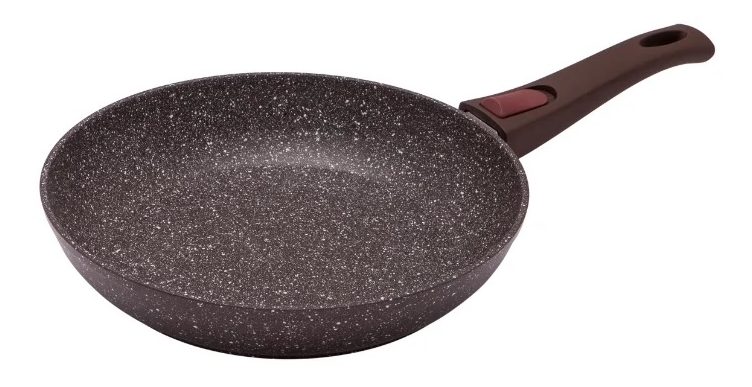
Advantages:
- Base - forged aluminum;
- Marble non-stick coating;
- Wall thickness 4 mm;
- Bottom thickness 4 mm;
- Different diameters to choose from;
- Acceptable cost;
- Dishwasher safe;
- Suitable for induction hob;
- Suitable for oven use;
- Removable handles.
Disadvantages:
- No cover included.
Average price: 1900 rubles.
When choosing a frying pan, it is very important to remember not only about the technical characteristics, but also about the convenience and appearance - after all, food cooked with pleasure and in dishes that brings joy is always tastier!
Choose wisely, and bon appetit!












